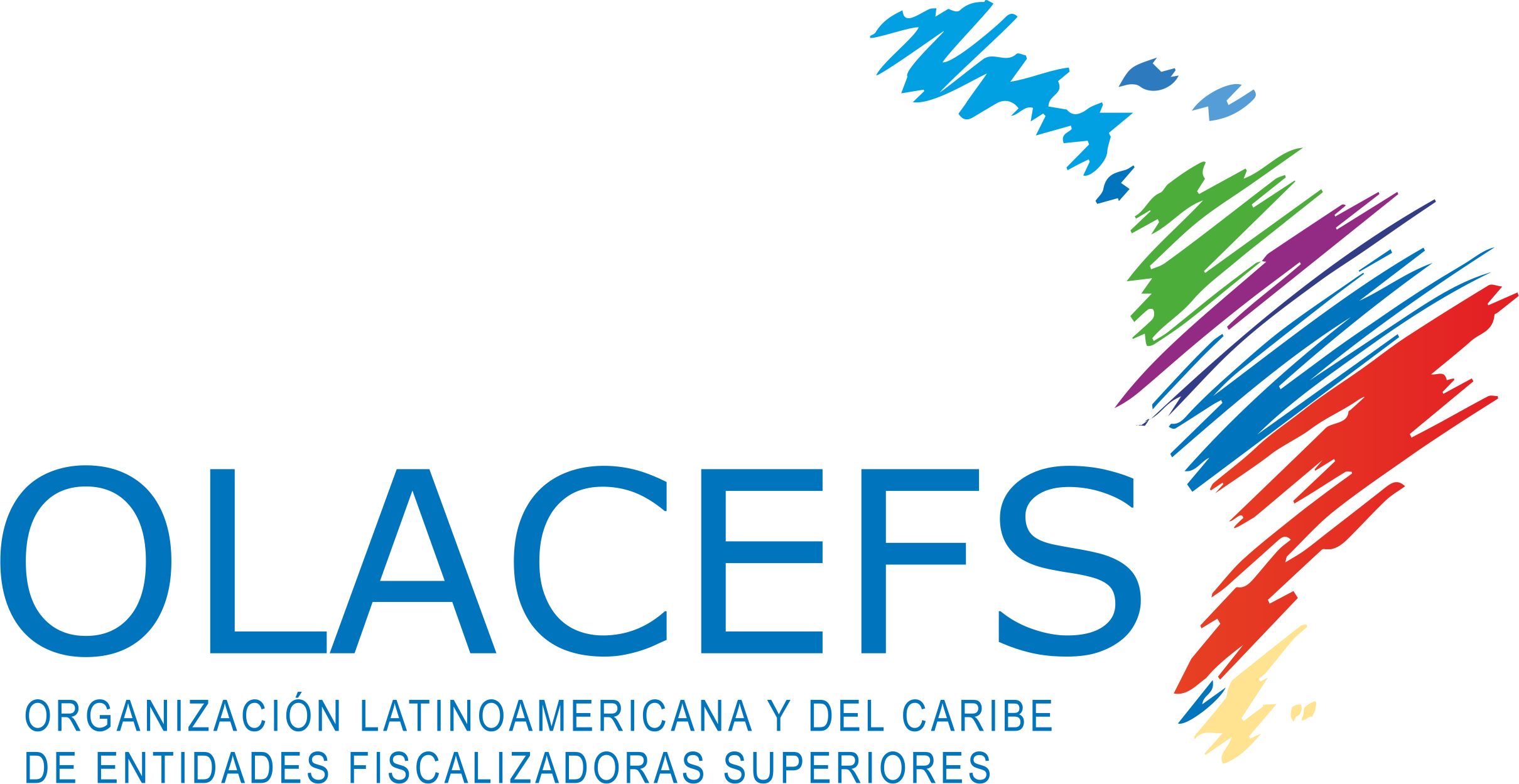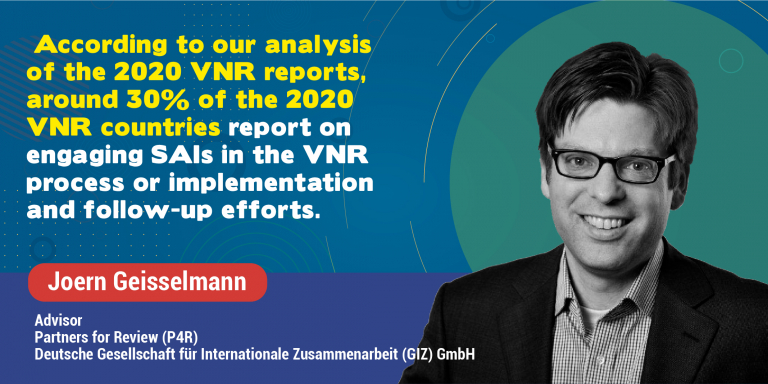Joern Geisselmann1
Advisor
Partners for Review (P4R)
Deutsche Gesellschaft für Internationale Zusammenarbeit (GIZ) GmbH
The 2030 Agenda for Sustainable Development aims to bring about a fundamental change towards more sustainability worldwide. When the Agenda was adopted in September 2015, UN member states pledged to commit to ‘a robust, voluntary, effective, participatory, transparent and integrated follow-up and review process at the national, regional and global levels’.
The responsibility for reporting on the implementation progress of the 2030 Agenda lies primarily with governments, who conduct Voluntary National Reviews (VNRs). A VNR can take 6-12 months and normally also involves various non-state actors. Its results are summarized in a report, which is shared with the international community at the annual High-level Political Forum on Sustainable Development (HLPF). From early on, supreme audit institutions (SAIs) have made important contributions to SDG follow-up and review.
Partners for Review (P4R) is a transnational multi-stakeholder network for government representatives and other state and non-state actors involved in the national follow-up and review of the 2030 Agenda for Sustainable Development. Initiated in 2016 on behalf of the German Federal Ministry for Economic Cooperation and Development (BMZ) and the Federal Ministry for the Environment, Nature Conservation and Nuclear Safety (BMU) and implemented by GIZ, the network’s objective is to contribute to developing effective global and national review and accountability mechanisms for achieving the SDGs. Since 2018, SAI representatives are regularly participating in P4R network meetings and other activities.
Based on our recent analysis of the 2020 VNR reports2 and the discussions that took place during P4R network meetings and other events organised by P4R, we have identified at least six ways how SAIs can contribute to SDG follow-up and review, three that have become quite common by now (the first three in the list below) and three that are implemented only by individual SAIs or not yet practiced at all (the last three in the list):
- By conducting SDG preparedness audits;
- By conducting SDG implementation audits;
- By contributing to the VNR;
- By auditing the VNR;
- By facilitating stakeholder engagement;
- By mainstreaming the SDGs into audit activities;
1. Conducting SDG preparedness audits
Since 2016, 73 SAIs and one sub-national audit office have conducted performance audits of their government’s preparedness to implement the 2030 Agenda3 . These efforts, among other things, helped kick-start the earnest implementation (e.g. Brazil, Canada), inspired the conduct of the first VNR (e.g. Gabon) or the development of a roadmap for the VNR process (e.g. Botswana) and led to changes in the design of the coordination mechanism or the composition of the coordinating body (e.g. Georgia, Spain). In some cases, the key results of these audits are featured in the VNR report.
2. Conducting SDG implementation audits
Now that the great majority of countries have embarked on implementing the 2030 Agenda and most of them have already conducted one or more VNRs, SAIs increasingly begin to audit the implementation of individual Goals or targets. In Latin America, for example, 18 countries have conducted a coordinated audit to assess the contribution of protected areas to life below water and on land (SDGs 14 & 15). Even more countries from various regions are participating in an ongoing cooperative audit of strong and resilient national public health systems (SDG target 3.d), supported by INTOSAI Development Initiative (IDI), INTOSAI Knowledge Sharing Committee (KSC) and INTOSAI Regions (ASOSAI, ARABOSAI and CAROSAI). Individual SAIs also conduct SDG implementation audits, e.g. Seychelles assessed the coastal and marine environment and its management (SDG 14) and Uganda is currently auditing governmental efforts to eliminate all forms of violence against all women and girls (SDG 5.2).
3. Contributing to the VNR
According to our analysis of the 2020 VNR reports1, around 30% of the 2020 VNR countries report on engaging SAIs in the VNR process or implementation and follow-up efforts. In most cases, SAIs performed audits to assess the government’s level of preparedness to implement the SDGs. Some countries not only described the contribution of SAIs in the report but invited them to contribute to its contents (e.g. Argentina, Bangladesh, Costa Rica, Samoa). In Samoa, the SAI is also a permanent observer in the coordinating SDG Taskforce. In addition, as mentioned above, preparedness audits have occasionally led to the decision to conduct a VNR or to develop a VNR roadmap.
4. Auditing the VNR
SAIs can also decide not to participate in the VNR process and to audit the process instead, including the report and the data used. To our knowledge, this has not been done yet, but it is encouraged by e.g. AFROSAI-E. In the UK, it was another entity, namely the parliamentary International Development Committee, that conducted an assessment of the 2019 VNR.
5. Facilitating stakeholder engagement
Some SAIs support stakeholder engagement for the SDGs. The SAI of Algeria, for instance, conducted the first national SDG Stakeholder Meeting of Algeria in 2018 to prioritize the issues facing Algeria with regard to the 2030 Agenda. The SAI of Chile has been organizing an international stakeholder conference on the SDGs since 2016, in which many stakeholders from civil society, government and academia share their knowledge on different subjects, such as good governance, environmental issues or improving public services. In Lithuania, the SAI is actively involving civil society and other non-state actors since 2017 in the ‘Signals’ conferences in order to discuss the government’s performance in SDG implementation and to raise awareness.
6. Mainstreaming the SDGs into audit activities
While not common, some SAIs have started mainstreaming the SDGs into their audit activities. Argentina reported in its 2020 VNR on specific capacity building to mainstream the SDGs in the mandates of the SAI. Similarly, Finland reported that it is developing a model for integrating the SDGs as a part of all external auditing.
Frontiers of learning
It is very impressive to see the response of the SAI community to the 2030 Agenda. The contribution of SAIs has from the beginning been resolute and was in many cases very important, sometimes even decisive to move the implementation forward. According to the discussions at our network meetings, the three following areas, among others, require further attention to maximise the impact of SAI contributions to national SDG follow-up and review:
- SAIs typically audit effectiveness and efficiency. In light of the objectives and principles of the 2030 Agenda there is a need to also audit inclusiveness and fairness. New approaches and tools are required for this purpose.
- Implementation audits require the auditing of outcomes and policy coherence, rather than only of individual programmes or entities. Some experiences with this exist already, but more is needed.
- The role of SAIs to hold governments accountable overlaps with those of other actors, e.g. media agencies, parliamentarians, and civil society organisations. It is encouraging to see that some SAIs have begun to create synergies with these actors.
1 With thanks to my colleague Miriam Rosa González for her useful comments on the initial draft.
2 P4R/GIZ (2020): ‘2020 Voluntary National Reviews – a snapshot of trends in SDG reporting’.
3 IDI-KSC (2019): ‘Are Nations Prepared for Implementation of the 2030 Agenda?’





